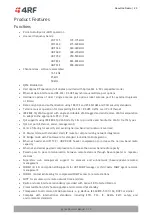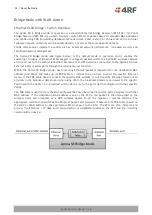
About the Radio | 23
Aprisa SRx User Manual 1.3.0
Product Features
Functions
Point-to-Multipoint (PMP) operation
Licensed frequency bands:
VHF 135
135-175 MHz
VHF 220
215-240 MHz
UHF 320
320-400 MHz
UHF 400
400-470 MHz
UHF 450
450-520 MHz
UHF 896
896-902 MHz
UHF 928
928-960 MHz
Channel sizes – software selectable:
12.5 kHz
25 kHz
50 kHz
QPSK Modulation
Half duplex RF operation (full duplex provided with Aprisa SR+ in 'SR compatible' mode)
Ethernet data interface and RS-232 / RS-485 asynchronous multiple port options
Hardware options of dual / single antenna port options (dual antenna port for external duplexers
or filters)
Data encryption and authentication using 128,192 and 256 bit AES and CCM security standards
Terminal server operation for transporting RS-232 / RS-485 traffic over IP or Ethernet
IEEE 802.1Q VLAN support with single and double VLAN tagged and add/remove VLAN manipulation
to adapt to the appropriate RTU / PLCs
QoS supports using IEEE 802.1p VLAN priority bits to prioritize and handle the VLAN / traffic types
QoS per port (Ethernet, serial, management)
L2/3/4 filtering for security and avoiding narrow band radio network overload
L3 Router mode with standard static IP route for simple routing network integration
L2 Bridge mode with VLAN aware for standard Industrial LAN integration
Ethernet header and IP/TCP / UDP ROHC header compression to increase the narrow band radio
capacity
Ethernet and serial payload compression to increase the narrow band radio capacity
Pseudo peer to peer communication between remote stations through base-repeater or repeater
stations
SuperVisor web management support for element and sub-network (base-repeater-remotes)
management
SNMPv1/2/3 & encryption MIB supports for 4RF SNMP manager or third party SNMP agent network
management
SNMPv3 context addressing for compressed SNMP access to remote stations
SNTP for accurate wide radio network time and date
Radio and user interface redundancy (provided with Aprisa SR Protected Station)
Protected Station fully hot swappable and monitored hot standby
Transparent to all common SCADA protocols; e.g. Modbus, IEC 60870-5-101/104, DNP3 or similar
Complies with international standards, including ETSI, FCC, IC, ACMA, EMC, safety and
environmental standards
















































